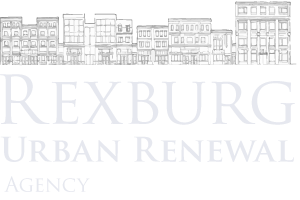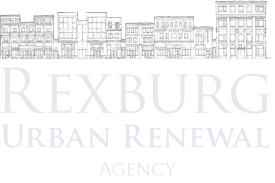Below are many of the frequently asked questions about urban renewal and the Rexburg URA. If you have a question that you can’t find an answer for, you can contact us.
The public benefits resulting from urban renewal and revenue allocation financing include:
- Job creation from the initial project as well as potential for “spinoff ” developments.
- Underutilized and deteriorated or deteriorating property is returned to productive use.
- Infrastructure upgrades enhance capacity for surrounding area and community at large.
- Improvements to local transportation systems benefit the community at large.
- Increasing local tax base may mean property owners enjoy lower levy rates in the future.
- Successful projects generate increased sales and income taxes for the state.
Urban renewal, also known as urban redevelopment and sometimes urban regeneration, is the systematic development of city areas and infrastructure by enhancing or restoring public buildings, roadways, industrial areas, water and sewage systems, sidewalks, parks, new housing, and other public amenities in accordance with comprehensive plans approved by the Mayor and City Council. Projects are funded by Tax increment financing (See tax increment financing).
The Rexburg Urban Renewal Agency, or Rexburg URA, is an independent public body serving the city of Rexburg, Idaho. The Rexburg URA consists of a seven-member commission that oversees and coordinates redevelopment efforts in Rexburg.
The Agency works to stimulate economic/commercial development under three primary goals:
-
The strengthening of the tax base by encouraging private development and thus increasing the assessed valuation of properties within the Revenue Allocation Area and benefiting the various taxing districts.
-
The assembly of land into parcels suitable for modern, integrated development with pedestrian and vehicular traffic.
-
The elimination of environmental deficiencies in the project areas.
These efforts are carried out within several “urban renewal districts” across Rexburg.
Urban renewal districts define the boundaries in which the Agency’s efforts are carried out. There are five urban renewal districts in Rexburg and each has a comprehensive plan and timeline approved by the city.
All board members are appointed by the Mayor. Each member serves as an unpaid volunteer. When a board member’s term ends, a new board member will be appointed by the Mayor. Board Members leaving the board before their term ends are replaced by the Board.
No. All board members serve as unpaid volunteers.
The City of Rexburg began to explore the use of tax increment financing as an economic development tool in 1990. The Rexburg Urban Renewal Agency was established by the City Council on November 6, 1991.
The basic authority to create urban renewal agencies and to undertake urban renewal projects is granted to all cities and counties in Idaho by the state legislature in Title 50, Chapter 20 of Idaho Code. The ability to use tax increment financing or as described in Idaho, revenue allocation financing for urban renewal projects is authorized under the Local Economic Development Act (Title 50, Chapter 29, Idaho Code).
Projects are primarily funded through the use of tax increment financing (TIF).
Tax Increment Financing (TIF) is a unique mechanism that enables an Urban Renewal Authority or board to use the net new tax revenues generated by projects within a designated urban renewal area to help finance future improvements. Tax increment financing is a new source of tax revenue, not an additional tax, that would not be available but for new investment.
When a redevelopment project is being planned, the Urban Renewal Authority or Board analyzes how much additional property and/or sales taxes may be generated once it is completed. That “tax increment” then can be used by the urban renewal entity either to finance the issuance of bonds or to reimburse developers for a portion of their project costs.
In either case, the new tax revenue that is created must be used for improvements that have a public benefit and that support the redevelopment effort, such as site clearance, streets, utilities, parks, the removal of hazardous materials or conditions, or site acquisition.

How it works
At the time an urban renewal district is formed, the County Assessor establishes the current value for each property in that district. This value is referred to as the “base” value. All property taxes on the “base value” continue to flow to the taxing districts within the urban renewal district, such as the county, the city, the highway district, etc. Over time, the assessed value of the properties in the urban renewal district will generally increase. That increase in value is referred to as “incremental value.” The property taxes generated by the incremental value above the base value go to the urban renewal agency to be reinvested in the specific urban renewal district.
For instance, if the district is approved in 2010, the assessed value of a property in 2010 becomes the “base value” and all property taxes on that value continue to flow to the usual taxing districts. If the property increases in value after the 2010 base year, the property taxes on the incremental value is distributed to the Agency.
An example would be: if a property was assessed by the County Assessor as having a value of $100,000 in 2010, the property taxes on that amount would all go to the usual taxing entities since that is the “base year value”. Then, if the property value increased to $110,000 in 2011, the taxes on the “base value” of $100,000 would still go to the usual taxing entities and the taxes on the “incremental” $10,000 would go to the Agency.
If the urban renewal district did not exist, taxes on the entire $110,000 value would go to the usual taxing entities so the total tax bill to the property owners remains the same.
History:
Beginning in the 1960s federal funds were the initial source of money for urban renewal projects in Idaho. As these funds were phased out in the 1970s, an alternative financing method was needed. In 1988, the Idaho state legislature adopted the Local Economic Development Act which authorized the use of tax increment financing. Under the Idaho Economic Development Act, urban renewal agencies now receive the majority of their funding from revenue allocation, otherwise known as “Tax Increment Revenue,” and, in some cases, bonds or other long-term debt secured by the Tax Increment Revenue.
By initiating the process of designating an area for urban renewal, a community is sending the message that they are interested in assisting with its revitalization. Through the planning process, market opportunities are identified and the private sector is engaged in understanding these opportunities, as well as the tools which are available to assist with project implementation. Property owners and businesses benefit from both the public and private commitments and investment through association and proximity.
It can affect your property values, and more often than not, in a positive way. Frequently, when an urban renewal area is designated, property values increase. This happens because many times private individuals begin to purchase land (speculation) in anticipation of both future development and increased property values. It also happens because properties located within an urban renewal area are often perceived by the development community as valuable because of the availability of financial incentives which are not available outside the district.
The boundaries of the area must be defined “as narrowly as possible. Conversely, the boundaries of the survey area can be defined more broadly in an effort to understand, comprehensively, the range of factors contributing to “blight.” Both areas may include some vacant and under‐utilized parcels and should include areas either adjacent to or influenced by key qualifying parcels.
No. The ability to condemn property is a right of any municipality under eminent domain, regardless of whether or not it is in an urban renewal area. The use of condemnation by government is limited to instances deemed necessary for the “public good” and usually as a last resort. Property for an urban renewal project is most often acquired by private interests in arms‐length transactions at fair market value. Most municipalities are extremely reluctant to use their condemnation powers for many reasons, not the least of which is the lengthy acquisition and negotiation process.
The same municipal regulations which applied prior to the urban renewal designation, apply after, e.g. zoning, special districts (if any), etc. The presence of urban renewal does not impose additional restrictions on property use. Rather, it makes available additional tools (incentives) to assist with implementation projects which are consistent with the urban renewal plan.
Neighborhoods are not necessarily declared “blighted,” rather, “areas are determined to have conditions present such that it can be determined eligible for an urban renewal designation.” The “area” in its entirety may or may not include a neighborhood or neighborhoods. Having a home within an urban renewal area should not have a direct impact in terms of value – either positive or negative – depending on its relationship to potential reinvestment zones. Experience has proven that properties within or in the vicinity of potential reinvestment activity tend to increase in value upon designation as an urban renewal area as property owners begin to speculate on the likelihood of acquisition offers.
There is no additional assessment to properties within an urban renewal area and no increase in the mill levy with formation of the district. Any increase in tax payments by property owners would be associated with an action other than creation of the urban renewal area, or an increase in the taxable value of property because of investments that are happening in the area. Residents within an area that are senior citizens are further protected under the Homestead Exemption. Referendum A, the homestead exemption for senior citizens, passed on a state‐ wide vote in November of 2001. The amendment provides an actual value reduction (exemption), up to a maximum of $100,000. This applies only to primary residences for citizens over the age of 65. Also, this actual value reduction is applicable only to a primary residence that has been owner‐occupied for the 10 years immediately preceding the subject tax year. This homestead exemption for senior citizens began with 2002 property taxes that were payable on or after January 1, 2003.
Question to Alan Dornfest, Idaho State Tax Commission, on November 19, 2008:
“Given the recent modifications to the urban renewal code resulting from bills generated in the past few legislative sessions, I would appreciate your current thoughts as to the impact of urban renewal districts on the local property taxpayer.”
Answer: “I would suggest that most of the changes in recent years and especially the changes resulting from HB 470 in 2008 and the legislation in 2007 that eliminated new construction within URDs from the budget capacity calculations until the dissolution of the revenue allocation areas add to the effective neutrality of urban renewal.” -Alan Dornfest

